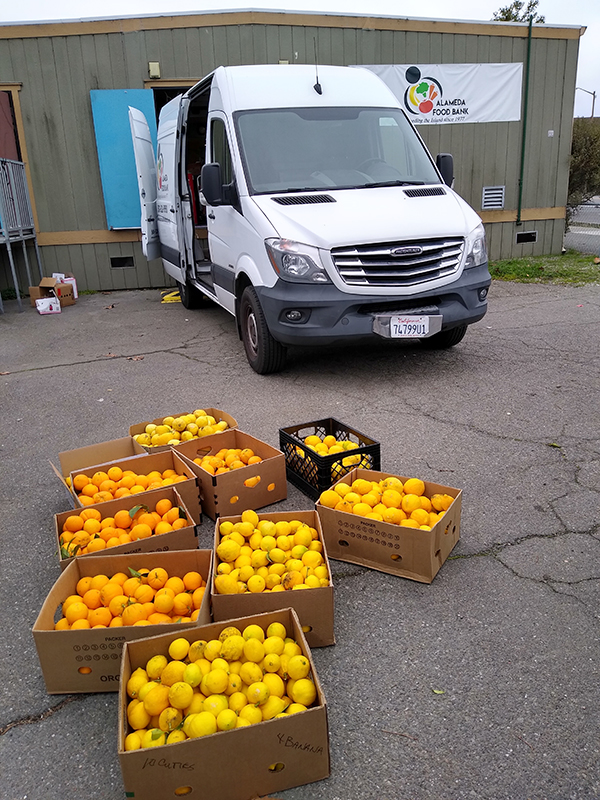
“Grow Some, Keep Some, Give Some Away”
If you are interested in volunteering to pick:
- Fill our our Volunteer Form
- Make sure your Volunteer Waiver is completed
- Watch our training video on picking
- Email us if you have any questions: info@alamedabackyardgrowers.org
Why Project Pick?
 According to Teale Harden, Executive Director of the Alameda Food Bank (AFB), since January 2022 the Alameda Food Bank has enrolled 800 new families and the demographics are changing. They are now seeing more families with kids, more senior citizens and even more people who are employed full-time but still can't make ends meet. In addition, food costs are rising and the AFB is spending 12% more than last year on food for their clients.
According to Teale Harden, Executive Director of the Alameda Food Bank (AFB), since January 2022 the Alameda Food Bank has enrolled 800 new families and the demographics are changing. They are now seeing more families with kids, more senior citizens and even more people who are employed full-time but still can't make ends meet. In addition, food costs are rising and the AFB is spending 12% more than last year on food for their clients.
Project Pick has provided the AFB with fresh, free backyard produce since 2011:
2011 - 996 lbs
2012 - 2,327 lbs
2013 - 5,202 lbs (approximately 1 pound of fresh fruit for each person using AFB resources)
2014 - 3,296 lbs
2015 - 2,661 lbs
2016 - 3,323 lbs
2017 - 2,830 lbs
2018 - 4,486 lbs
2019 - 7,504 lbs
2020 - 8,143 lbs - 2nd BEST YEAR EVER!
2021 - 7,041 lbs
2022 - 8,032 lbs - 3rd SECOND BEST YEAR EVER!
2023 - 6,853 lbs
2024 - 7,523 lbs
2025 - 10,001 lbs to date - BEST YEAR EVER! Exceeded initial goal (8,500 lbs) on 3/22/25 and reached second goal (10,001) on 5/10/25
Over 79,152 pounds (over 39 tons) of fruit donated in total!
Food Insecurity
Our local statistics are in line with national trends. According to USDA findings, an estimated 12.7 percent of American households were food insecure at least some time during the year in 2015, meaning they lacked access to enough food for an active, healthy life for all household members. During the pandemic, the Alameda Food Bank (AFB) faced a nearly tenfold increase in clients after the pandemic hit, going from serving about 800 families each month to up to 1,800 each week!
Wasted Food
At the same time 30-40% of the food produced in the United States is wasted — either thrown out by supermarkets or consumers or left to rot in fields because the cost to harvest it would exceed what the farmer could make selling it. Fruit from trees often goes to waste either because there is too much of it in a short space of time to be used or because the tree’s owner doesn’t have the ability or the time to harvest it.
With Project Pick We Can Make a Difference!
An established fruit tree can often produce 100+ pounds of fruit, far more than one family can consume. If you have a fruit tree that produces more fruit than you can use, why not donate the excess to the Alameda Food Bank’s Perishable Food Program and help make a difference in the lives of your neighbors? A little or a lot — it’s all valuable and helps reduce the amount of perfectly good food going to waste in America. Read an article about Project Pick published in the Alameda Sun here.
Ways You Can Help
1) You Pick & We Deliver
You can harvest your tree yourself and then email info@alamedabackyardgrowers.org or leave a message at 510-239-PICK (7425) and we will pick up your fruit and deliver it to the Alameda Food Bank for you. We generally deliver on Monday, Wednesday and Friday morning, so please consider picking on Sunday, Tuesdays or Thursdays. Remember to keep the harvested fruit in a shady location that is also accessible to the ABG volunteer. Finally, please place the fruit in containers that you do not want returned to you (double paper grocery bags, cardboard boxes that one person can lift, or strong plastic bags). For helpful guidelines on picking fruit, please click here.
2) We Pick & Deliver
We can harvest your tree for you and deliver the excess fruit to the Alameda Food Bank on your behalf. Please list information about your tree by filling out a brief form. You can also leave a message at 510-239-PICK with your name, location and best way to contact you. Volunteers are happy to pick some of the fruit for you as well if you are unable to harvest it for yourself.

Gleaning Guide to Help Other Communities Start Their Own Programs
Working in collaboration with Alameda County's StopWaste, Alameda Backyard Growers developed a gleaning guide to encourage and support other communities to start their own gleaning programs. There is so much fresh produce that can be collected around the East Bay and shared with people in need. We hope that groups will contact us with any questions they have or information they need to get gleaning going! Read more about and download the Gleaning Guide from this page.
